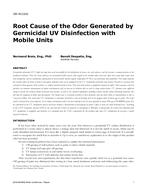Description
Germicidal ultraviolet (UV) light has long been used successfully for the disinfection of water, air, and surfaces, and has become a common practice in the healthcare industry. There has been, however, an unresolved health concern with regard to the residual odors that have often been noted after rooms have been disinfected, and no satisfactory explanation of these possible volatile organic compounds (VOCs) has previously been published. This study explains the residual odors in terms of thiol or mercaptan molecules that can be produced by the UV irradiation of keratin and cysteine. Keratin is a protein that is found in skin squames while cysteine is a similar molecule found in hair. They also both contain a significant amount of sulfur. Skin squames and hair particles are common contaminants of indoor environments and are present in airborne dust as well as being surface-borne. UV photons carry sufficient energy to break the chemical bonds of keratin and cysteine, as well as the chemical byproducts including volatile smaller sulfur-containing molecules that fall into the categories of thiols and mercaptans. The human nose is extremely sensitive to these molecules and can detect them at concentrations as low as 1 part per billion. The smell after UV disinfection is sometimes described as that of burning hair or the pungent odor of rotten eggs or garlic. The latter smell is characteristic of mercaptans. In an indoor environment where the dust loading in the air may typically be about 100 ug/m3(0.000044 grain/ft3), the aftermath of the UV disinfection process will leave behind a concentration of mercaptans of about 2 ppb, or twice the smell threshold level. According to the CSST in Quebec and per OSHA, the safe level for 8 hours of exposure to mercaptans is 500 ppb. Consequently, the actual level obtained after UV disinfection is negligible and therefore it is concluded that the VOCs responsible for the residual odor after UV disinfection do not pose a health hazard to humans.
Citation: 2016 Winter Conference, Orlando, FL, Conference Papers
Product Details
- Published:
- 2016
- Number of Pages:
- 8
- Units of Measure:
- Dual
- File Size:
- 1 file , 1 MB
- Product Code(s):
- D-OR-16-C033




